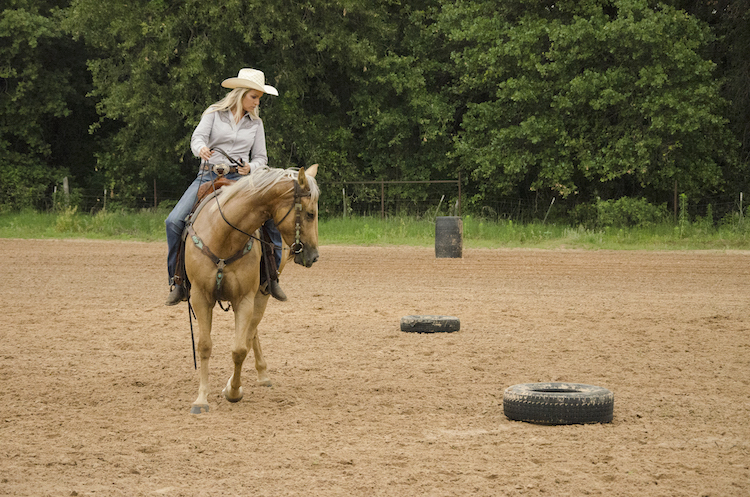By Danyelle Cambell
Professional barrel racer, trainer and National Finals Rodeo qualifier Danyelle Campbell uses the basic steps of her circular five-tire drill to achieve correct body position. This drill enables riders to perfect their horse’s shape and collection in the turns without the monotony of repeatedly navigating the barrel pattern. It allows the rider to focus on the horse’s proper body position in a calm and relaxed manner.
“Drills aren’t necessarily about set patterns or set obstacles that you go around. Drills are in your head,” Campbell said. “The only thing we do drills for is to reinforce proper body positioning and general relaxation in our horses. So be creative; come up with your own. You don’t always need barrels, you don’t always need tires; you can use bushes, trees or invisible objects on the ground.”
Step No. 1
First, place five tires approximately 25 feet apart in a circular pattern on the ground in your arena or riding area. For added variation to work on approaching and leaving a barrel, place a barrel inside the middle of the tires—pictured in photo A.
“The tires give me, the rider, a guideline of what I’m doing and where I’m going. It also takes the anticipation away for the horse,” Campbell said. “I can teach body positioning without a large barrel; a tire is pretty obsolete down there on the ground. It’s basically a guideline for us. I can teach a horse proper body positioning and how to move his feet by giving myself a visual aid of the tire but without my horse really associating himself to it.
As far as an open horse goes, I think it teaches good body positioning and keeping a horse really honest in the turn without anticipating the turn and diving in like they might a barrel.”

Step No. 2
Once your tire pattern is set, begin traveling around the outside of each tire at a walk or trot. Begin left or right, but circle each tire the same direction while keeping the horse’s shoulder picked up and framed around the turn while moving to the next tire. The point of this drill is to maintain forward movement while keeping a horse honest in his turns. Therefore, hold the horse’s body position throughout the entire process and while moving to the next tire by keeping the horse arced to the inside of the turn, his shoulder up and body moving forward. Keep the tire in the middle of your circle without allowing the horse to drift out or move in toward the tire until you are to the next tire. Then turn that tire, keeping all of the same fundamentals in mind.
“Go around the outside of the tires and turn each one to the left,” Campbell said. “In between tires, hold bend in your horse’s body without allowing him to float out or in to work on the horse holding its shape, keeping its frame and keeping its shoulders up. When I turn a tire I’ll look to the next tire, and while moving forward give my horse a pocket just like it were a barrel. I keep the tire in the middle of my circle as I turn the next tire.”
Pro Tip: For a horse that needs help gathering himself and getting soft before a turn at the last minute—like you would prefer to feel during a barrel run—use the following variation: As you come around the tire at a walk or trot, keep the tire in the middle of your circle. At the backside of your circle let his head go straight and encourage forward motion out of the turn. When you get to the next tire gather the horse, collect his face and shoulder, tip his nose to the inside and turn the tire as you would a barrel, keeping correct position.
Step No. 3
When you’re ready to switch directions, cross over in between the tire you’ve left and the next one. Pick up your horse’s shoulder, make sure your horse’s body is framed, tip his nose to the outside of the circle and turn the next tire in the opposite direction you’ve been riding. You will now be traveling to the right (if you were going to the left first) and your right hand will now be the inside rein hand. Repeat steps 1–3 going this direction.
Step No. 4
Adding speed to this drill is best done no faster than a lope. Begin by loping a large circle around the outside of the five tires, without turning any specific tire. If a horse is tense or drifting in toward the tires, don’t be afraid to circle the tires more than once until the horse is calm and relaxed. Then, begin circling the tires just as you did in steps 1–3, this time at a lope. Ensure your horse is on the correct lead in each direction.
Pro Tip: Campbell never lets a horse start a turn if the horse is not soft and set up for the turn. She says she makes turning a reward for the horse having a soft body.



